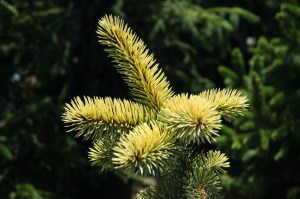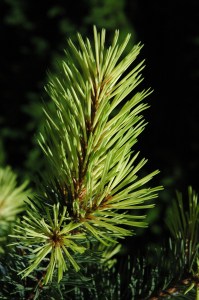Winter appears to have a death grip on the eastern half of the U.S. for the second year in a row. The thermometer on my car read -6 F on my way into work this morning; with lows of -5, -11, and -2 predicted for the latter half of the week. And to my Northwest friends that have been out mowing their grass already, may the bird of paradise fly up your nose. At this point I don’t even remember what my lawn looks like.
Evergreen conifers provide one horticultural escape from the winter blahs. But evergreens don’t have to be green. One group of conifers that can brighten up a winter landscape are yellow or golden conifers. I will acknowledge these plants are not for everyone. But when sited properly (avoid winter sun is a common admonition among conifer buffs) and used judiciously (a little yellow goes a long ways) these conifers can add a contrasting element that can set off a garden. Note: Hardiness zone and size based on the American Conifers Society Conifer database.

Picea orientalis ‘Skylands’ (Skylands Oriental spruce) Zone 4. Size: Large (> 12” per year). This tree is a guaranteed show stopper. The combination of the narrow upright form and golden needles is tough to beat.

Picea orientalis ‘Firefly’ (Firefly Oriental spruce) Zone 4. Size: Intermediate (6’-12” per year). Firefly was selected as a sport off of ‘Skylands’ and is a recent introduction from Iseli nursery. So if you like Skylands but don’t have room for large conifer, this could be for you.

Chamaecyparis pisifera ‘Filifera Aurea’ (Golden thread false cypress) Zone 5. Size: Intermediate (6”-12” per year). This a tough plant that can make a good contrast specimen or can also serve as a foundation plant.

Golden thread false cypress as a foundation planting at the Missouri Botanical Garden

Picea pungens ‘Lutea’ (Golden Colorado spruce) Zone 4. Who says blue spruce have to be blue? Lots of concerns with blue spruce in the Midwest these days (more on that in later posts), but if you’re in an area where blue spruce are still doing well, this is an option for a winter bright spot.

Pinus contorta ‘Taylor’s sunburst’ (Taylor’s sunburst lodgepole pine) Zone 3. Ok, I’m cheating a bit here – the yellow comes on the new growth in the spring and then turns green. ACS database lists as a large conifer but I think they are referring to the straight species. When I have seen this plant it’s more in the intermediate range (6” – 12” per year).


